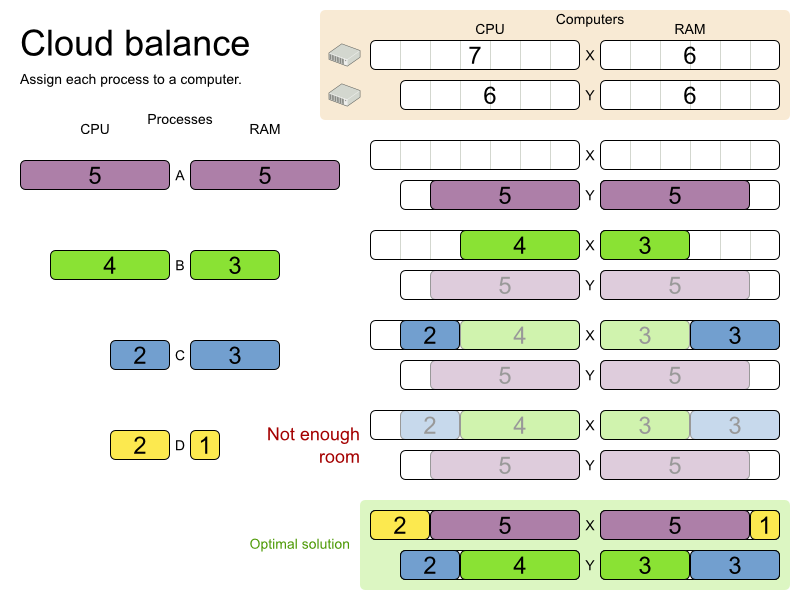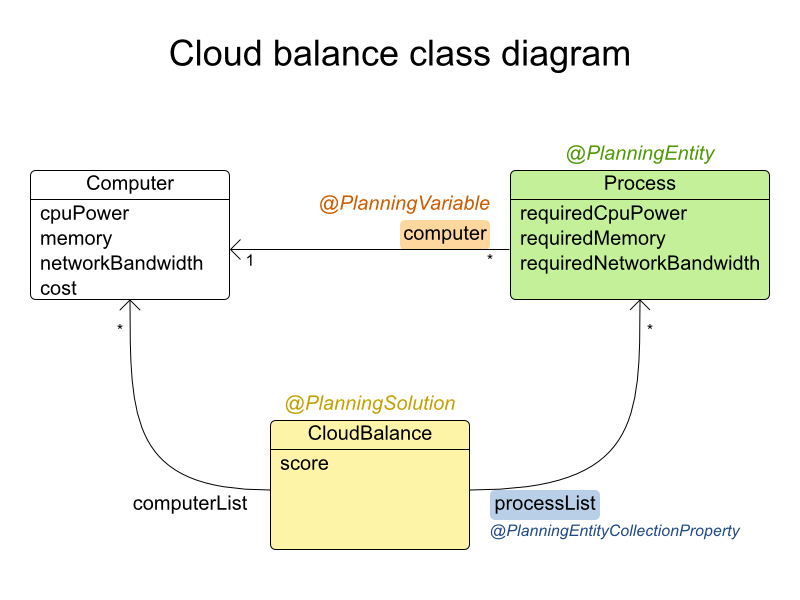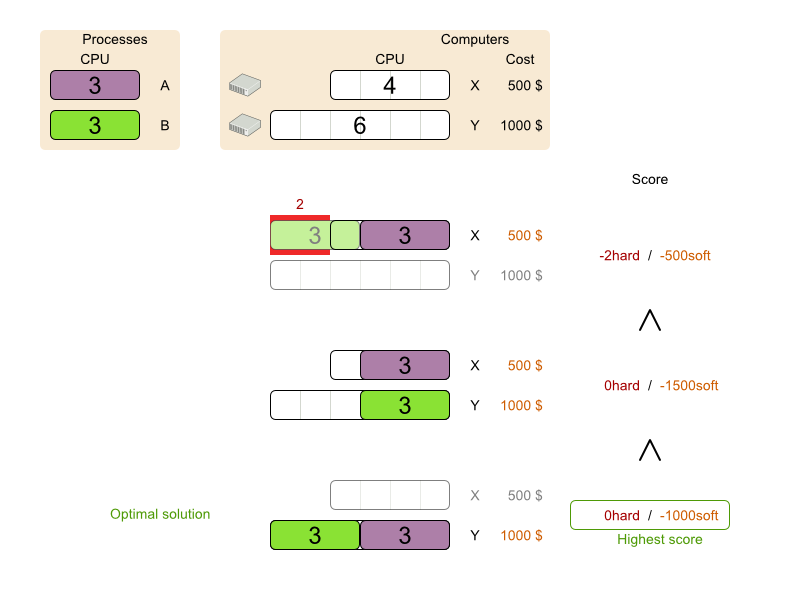Suppose your company owns a number of cloud computers and needs to run a number of processes on those computers. Assign each process to a computer.
The following hard constraints must be fulfilled:
Every computer must be able to handle the minimum hardware requirements of the sum of its processes:
CPU capacity: The CPU power of a computer must be at least the sum of the CPU power required by the processes assigned to that computer.
Memory capacity: The RAM memory of a computer must be at least the sum of the RAM memory required by the processes assigned to that computer.
Network capacity: The network bandwidth of a computer must be at least the sum of the network bandwidth required by the processes assigned to that computer.
The following soft constraints should be optimized:
Each computer that has one or more processes assigned, incurs a maintenance cost (which is fixed per computer).
Cost: Minimize the total maintenance cost.
This problem is a form of bin packing. The following is a simplified example, in which we assign four processes to two computers with two constraints (CPU and RAM) with a simple algorithm:

The simple algorithm used here is the First Fit Decreasing algorithm, which assigns the
bigger processes first and assigns the smaller processes to the remaining space. As you can see, it is not
optimal, as it does not leave enough room to assign the yellow process D.
Planner does find the more optimal solution by using additional, smarter algorithms. It also scales: both in data (more processes, more computers) and constraints (more hardware requirements, other constraints). So let's see how Planner can be used in this scenario.
Here's executive summary of this example and a more advanced implementation with more constraints:

Table 2.1. Cloud Balancing Problem Size
| Problem Size | Computers | Processes | Search Space |
|---|---|---|---|
| 2computers-6processes | 2 | 6 | 64 |
| 3computers-9processes | 3 | 9 | 10^4 |
| 4computers-012processes | 4 | 12 | 10^7 |
| 100computers-300processes | 100 | 300 | 10^600 |
| 200computers-600processes | 200 | 600 | 10^1380 |
| 400computers-1200processes | 400 | 1200 | 10^3122 |
| 800computers-2400processes | 800 | 2400 | 10^6967 |
Beginning with the domain model:
Computer: represents a computer with certain hardware (CPU power, RAM memory, network bandwidth) and maintenance cost.Process: represents a process with a demand. Needs to be assigned to aComputerby Planner.CloudBalance: represents a problem. Contains everyComputerandProcessfor a certain data set.

In the UML class diagram above, the Planner concepts are already annotated:
Planning entity: the class (or classes) that changes during solving. In this example, it is the class
Process.Planning variable: the property (or properties) of a planning entity class that changes during solving. In this example, it is the property
computeron the classProcess.Planning solution: the class that represents a data set and contains all planning entities. In this example that is the class
CloudBalance.
Try it yourself. Download and configure the examples in your
preferred IDE. Run org.optaplanner.examples.cloudbalancing.app.CloudBalancingHelloWorld.
By default, it is configured to run for 120 seconds. It will execute this code:
Example 2.1. CloudBalancingHelloWorld.java
public class CloudBalancingHelloWorld {
public static void main(String[] args) {
// Build the Solver
SolverFactory<CloudBalance> solverFactory = SolverFactory.createFromXmlResource(
"org/optaplanner/examples/cloudbalancing/solver/cloudBalancingSolverConfig.xml");
Solver<CloudBalance> solver = solverFactory.buildSolver();
// Load a problem with 400 computers and 1200 processes
CloudBalance unsolvedCloudBalance = new CloudBalancingGenerator().createCloudBalance(400, 1200);
// Solve the problem
CloudBalance solvedCloudBalance = solver.solve(unsolvedCloudBalance);
// Display the result
System.out.println("\nSolved cloudBalance with 400 computers and 1200 processes:\n"
+ toDisplayString(solvedCloudBalance));
}
...
}The code example does the following:
Build the
Solverbased on a solver configuration (in this case an XML file from the classpath).SolverFactory<CloudBalance> solverFactory = SolverFactory.createFromXmlResource( "org/optaplanner/examples/cloudbalancing/solver/cloudBalancingSolverConfig.xml"); Solver solver<CloudBalance> = solverFactory.buildSolver();Load the problem.
CloudBalancingGeneratorgenerates a random problem: you will replace this with a class that loads a real problem, for example from a database.CloudBalance unsolvedCloudBalance = new CloudBalancingGenerator().createCloudBalance(400, 1200);Solve the problem.
CloudBalance solvedCloudBalance = solver.solve(unsolvedCloudBalance);Display the result.
System.out.println("\nSolved cloudBalance with 400 computers and 1200 processes:\n" + toDisplayString(solvedCloudBalance));
The only complicated part is building the Solver, as detailed in the next section.
Take a look at the solver configuration:
Example 2.2. cloudBalancingSolverConfig.xml
<?xml version="1.0" encoding="UTF-8"?>
<solver>
<!-- Domain model configuration -->
<scanAnnotatedClasses/>
<!-- Score configuration -->
<scoreDirectorFactory>
<scoreDefinitionType>HARD_SOFT</scoreDefinitionType>
<easyScoreCalculatorClass>org.optaplanner.examples.cloudbalancing.solver.score.CloudBalancingEasyScoreCalculator</easyScoreCalculatorClass>
<!--<scoreDrl>org/optaplanner/examples/cloudbalancing/solver/cloudBalancingScoreRules.drl</scoreDrl>-->
</scoreDirectorFactory>
<!-- Optimization algorithms configuration -->
<termination>
<secondsSpentLimit>30</secondsSpentLimit>
</termination>
</solver>This solver configuration consists of three parts:
Domain model configuration: What can Planner change? We need to make Planner aware of our domain classes. In this configuration, it will automatically scan all classes in your classpath (for an
@PlanningEntityor@PlanningSolutionannotation):<scanAnnotatedClasses/>Score configuration: How should Planner optimize the planning variables? What is our goal? Since we have hard and soft constraints, we use a
HardSoftScore. But we also need to tell Planner how to calculate the score, depending on our business requirements. Further down, we will look into two alternatives to calculate the score: using an easy Java implementation, or using Drools DRL.<scoreDirectorFactory> <scoreDefinitionType>HARD_SOFT</scoreDefinitionType> <easyScoreCalculatorClass>org.optaplanner.examples.cloudbalancing.solver.score.CloudBalancingEasyScoreCalculator</easyScoreCalculatorClass> <!--<scoreDrl>org/optaplanner/examples/cloudbalancing/solver/cloudBalancingScoreRules.drl</scoreDrl>--> </scoreDirectorFactory>Optimization algorithms configuration: How should Planner optimize it? In this case, we use the default optimization algorithms (because no explicit optimization algorithms are configured) for 30 seconds:
<termination> <secondsSpentLimit>30</secondsSpentLimit> </termination>Planner should get a good result in seconds (and even in less than 15 milliseconds with real-time planning), but the more time it has, the better the result will be. Advanced use cases will likely use a different termination criteria than a hard time limit.
The default algorithms will already easily surpass human planners and most in-house implementations. Use the Benchmarker to power tweak to get even better results.
Let's examine the domain model classes and the score configuration.
The Computer class is a POJO (Plain Old Java Object). Usually, you will have more of
this kind of classes with input data.
Example 2.3. CloudComputer.java
public class CloudComputer ... {
private int cpuPower;
private int memory;
private int networkBandwidth;
private int cost;
... // getters
}The Process class is particularly important. It is the class that is modified during
solving. We need to tell Planner that it can change the property computer, so we annotate the
class with @PlanningEntity and the getter getComputer() with
@PlanningVariable. Of course, the property computer needs a setter too, so
Planner can change it during solving.
Example 2.4. CloudProcess.java
@PlanningEntity(...)
public class CloudProcess ... {
private int requiredCpuPower;
private int requiredMemory;
private int requiredNetworkBandwidth;
private CloudComputer computer;
... // getters
@PlanningVariable(valueRangeProviderRefs = {"computerRange"})
public CloudComputer getComputer() {
return computer;
}
public void setComputer(CloudComputer computer) {
computer = computer;
}
// ************************************************************************
// Complex methods
// ************************************************************************
...
}Planner needs to know which values it can choose from to assign to the property
computer. Those values are retrieved from the method
CloudBalance.getComputerList() on the planning solution, which returns a list of all
computers in the current data set. The @PlanningVariable's
valueRangeProviderRefs parameter on CloudProcess.getComputer() needs to
match with the @ValueRangeProvider's id on
CloudBalance.getComputerList().
Note
Instead of getter annotations, it is also possible to use field annotations.
The CloudBalance class has a @PlanningSolution annotation. It
holds a list of all computers and processes. It represents both the planning problem and (if it's initialized)
the planning solution.
Planner needs to retrieve the collection of processes that it can change, therefore we annotate the getter
getProcessList() with @PlanningEntityCollectionProperty.
The CloudBalance class also has a @PlanningScore annotated property
score, which is the Score of that solution in its current state. Planner
automatically updates it when it calculates a Score for a solution instance and therefore it
needs a setter.
Example 2.5. CloudBalance.java
@PlanningSolution
public class CloudBalance ... {
private List<CloudComputer> computerList;
private List<CloudProcess> processList;
private HardSoftScore score;
@ValueRangeProvider(id = "computerRange")
@ProblemFactCollectionProperty
public List<CloudComputer> getComputerList() {
return computerList;
}
@PlanningEntityCollectionProperty
public List<CloudProcess> getProcessList() {
return processList;
}
@PlanningScore
public HardSoftScore getScore() {
return score;
}
public void setScore(HardSoftScore score) {
this.score = score;
}
...
}Especially for score calculation with Drools, the property computerList needs to be
annotated with a @ProblemFactCollectionProperty so the computers are known to it.
Planner will search for the Solution with the highest Score. This
example uses a HardSoftScore, which means Planner will look for the solution with no hard
constraints broken (fulfill hardware requirements) and as little as possible soft constraints broken (minimize
maintenance cost).

Of course, Planner needs to be told about these domain-specific score constraints. There are several ways to implement such a score function:
Easy Java
Incremental Java
Drools
Let's take a look at two different implementations:
One way to define a score function is to implement the interface EasyScoreCalculator in
plain Java.
<scoreDirectorFactory>
<scoreDefinitionType>HARD_SOFT</scoreDefinitionType>
<easyScoreCalculatorClass>org.optaplanner.examples.cloudbalancing.solver.score.CloudBalancingEasyScoreCalculator</easyScoreCalculatorClass>
</scoreDirectorFactory>Just implement the calculateScore(Solution) method to return a
HardSoftScore instance.
Example 2.6. CloudBalancingEasyScoreCalculator.java
public class CloudBalancingEasyScoreCalculator implements EasyScoreCalculator<CloudBalance> {
/**
* A very simple implementation. The double loop can easily be removed by using Maps as shown in
* {@link CloudBalancingMapBasedEasyScoreCalculator#calculateScore(CloudBalance)}.
*/
public HardSoftScore calculateScore(CloudBalance cloudBalance) {
int hardScore = 0;
int softScore = 0;
for (CloudComputer computer : cloudBalance.getComputerList()) {
int cpuPowerUsage = 0;
int memoryUsage = 0;
int networkBandwidthUsage = 0;
boolean used = false;
// Calculate usage
for (CloudProcess process : cloudBalance.getProcessList()) {
if (computer.equals(process.getComputer())) {
cpuPowerUsage += process.getRequiredCpuPower();
memoryUsage += process.getRequiredMemory();
networkBandwidthUsage += process.getRequiredNetworkBandwidth();
used = true;
}
}
// Hard constraints
int cpuPowerAvailable = computer.getCpuPower() - cpuPowerUsage;
if (cpuPowerAvailable < 0) {
hardScore += cpuPowerAvailable;
}
int memoryAvailable = computer.getMemory() - memoryUsage;
if (memoryAvailable < 0) {
hardScore += memoryAvailable;
}
int networkBandwidthAvailable = computer.getNetworkBandwidth() - networkBandwidthUsage;
if (networkBandwidthAvailable < 0) {
hardScore += networkBandwidthAvailable;
}
// Soft constraints
if (used) {
softScore -= computer.getCost();
}
}
return HardSoftScore.valueOf(hardScore, softScore);
}
}Even if we optimize the code above to use Maps to iterate through the
processList only once, it is still slow because it does not
do incremental score calculation. To fix that, either use
incremental Java score calculation or Drools score calculation. Let's take a look at the latter.
To use the Drools rule engine as a score function, simply add a scoreDrl resource in
the classpath:
<scoreDirectorFactory>
<scoreDefinitionType>HARD_SOFT</scoreDefinitionType>
<scoreDrl>org/optaplanner/examples/cloudbalancing/solver/cloudBalancingScoreRules.drl</scoreDrl>
</scoreDirectorFactory>First, we want to make sure that all computers have enough CPU, RAM and network bandwidth to support all their processes, so we make these hard constraints:
Example 2.7. cloudBalancingScoreRules.drl - Hard Constraints
...
import org.optaplanner.examples.cloudbalancing.domain.CloudBalance;
import org.optaplanner.examples.cloudbalancing.domain.CloudComputer;
import org.optaplanner.examples.cloudbalancing.domain.CloudProcess;
global HardSoftScoreHolder scoreHolder;
// ############################################################################
// Hard constraints
// ############################################################################
rule "requiredCpuPowerTotal"
when
$computer : CloudComputer($cpuPower : cpuPower)
$requiredCpuPowerTotal : Number(intValue > $cpuPower) from accumulate(
CloudProcess(
computer == $computer,
$requiredCpuPower : requiredCpuPower),
sum($requiredCpuPower)
)
then
scoreHolder.addHardConstraintMatch(kcontext, $cpuPower - $requiredCpuPowerTotal.intValue());
end
rule "requiredMemoryTotal"
...
end
rule "requiredNetworkBandwidthTotal"
...
endNext, if those constraints are met, we want to minimize the maintenance cost, so we add that as a soft constraint:
Example 2.8. cloudBalancingScoreRules.drl - Soft Constraints
// ############################################################################
// Soft constraints
// ############################################################################
rule "computerCost"
when
$computer : CloudComputer($cost : cost)
exists CloudProcess(computer == $computer)
then
scoreHolder.addSoftConstraintMatch(kcontext, - $cost);
endIf you use the Drools rule engine for score calculation, you can integrate with other Drools technologies, such as decision tables (XLS or web based), the KIE Workbench, ...
Now that this simple example works, try going further. Enrich the domain model and add extra constraints such as these:
Each
Processbelongs to aService. A computer might crash, so processes running the same service should be assigned to different computers.Each
Computeris located in aBuilding. A building might burn down, so processes of the same services should be assigned to computers in different buildings.